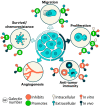Galectins as Emerging Glyco-Checkpoints and Therapeutic Targets in Glioblastoma
- PMID: 35008740
- PMCID: PMC8745137
- DOI: 10.3390/ijms23010316
Galectins as Emerging Glyco-Checkpoints and Therapeutic Targets in Glioblastoma
Abstract
Despite recent advances in diagnosis and treatment, glioblastoma (GBM) represents the most common and aggressive brain tumor in the adult population, urging identification of new rational therapeutic targets. Galectins, a family of glycan-binding proteins, are highly expressed in the tumor microenvironment (TME) and delineate prognosis and clinical outcome in patients with GBM. These endogenous lectins play key roles in different hallmarks of cancer by modulating tumor cell proliferation, oncogenic signaling, migration, vascularization and immunity. Additionally, they have emerged as mediators of resistance to different anticancer treatments, including chemotherapy, radiotherapy, immunotherapy, and antiangiogenic therapy. Particularly in GBM, galectins control tumor cell transformation and proliferation, reprogram tumor cell migration and invasion, promote vascularization, modulate cell death pathways, and shape the tumor-immune landscape by targeting myeloid, natural killer (NK), and CD8+ T cell compartments. Here, we discuss the role of galectins, particularly galectin-1, -3, -8, and -9, as emerging glyco-checkpoints that control different mechanisms associated with GBM progression, and discuss possible therapeutic opportunities based on inhibition of galectin-driven circuits, either alone or in combination with other treatment modalities.
Keywords: angiogenesis; central nervous system; galectins; glioblastoma; glycans; glyco-checkpoints; immunomodulation; immunotherapy; invasion.
Conflict of interest statement
The authors declare no conflict of interest.
Figures


Similar articles
-
Decoding Strategies to Evade Immunoregulators Galectin-1, -3, and -9 and Their Ligands as Novel Therapeutics in Cancer Immunotherapy.Int J Mol Sci. 2022 Dec 8;23(24):15554. doi: 10.3390/ijms232415554. Int J Mol Sci. 2022. PMID: 36555198 Free PMC article. Review.
-
Glycan-Lectin Interactions as Novel Immunosuppression Drivers in Glioblastoma.Int J Mol Sci. 2022 Jun 5;23(11):6312. doi: 10.3390/ijms23116312. Int J Mol Sci. 2022. PMID: 35682991 Free PMC article. Review.
-
Engineering galectin-glycan interactions for immunotherapy and immunomodulation.Exp Biol Med (Maywood). 2016 May;241(10):1074-83. doi: 10.1177/1535370216650055. Exp Biol Med (Maywood). 2016. PMID: 27229902 Free PMC article. Review.
-
Impact of Galectins in Resistance to Anticancer Therapies.Clin Cancer Res. 2020 Dec 1;26(23):6086-6101. doi: 10.1158/1078-0432.CCR-18-3870. Epub 2020 Jul 24. Clin Cancer Res. 2020. PMID: 32709716 Review.
-
Coupling pathogen recognition to innate immunity through glycan-dependent mechanisms.Int Immunopharmacol. 2011 Oct;11(10):1457-63. doi: 10.1016/j.intimp.2011.05.002. Epub 2011 May 18. Int Immunopharmacol. 2011. PMID: 21600310 Review.
Cited by
-
Vascular galectins in tumor angiogenesis and cancer immunity.Semin Immunopathol. 2024 Jul 11;46(1-2):3. doi: 10.1007/s00281-024-01014-9. Semin Immunopathol. 2024. PMID: 38990363 Free PMC article. Review.
-
Galectins and galectin-mediated autophagy regulation: new insights into targeted cancer therapy.Biomark Res. 2023 Feb 22;11(1):22. doi: 10.1186/s40364-023-00466-9. Biomark Res. 2023. PMID: 36814341 Free PMC article. Review.
-
The Blessed Union of Glycobiology and Immunology: A Marriage That Worked.Medicines (Basel). 2023 Jan 19;10(2):15. doi: 10.3390/medicines10020015. Medicines (Basel). 2023. PMID: 36827215 Free PMC article. Review.
-
Decoding Strategies to Evade Immunoregulators Galectin-1, -3, and -9 and Their Ligands as Novel Therapeutics in Cancer Immunotherapy.Int J Mol Sci. 2022 Dec 8;23(24):15554. doi: 10.3390/ijms232415554. Int J Mol Sci. 2022. PMID: 36555198 Free PMC article. Review.
-
Glycobiology of Cancer: Sugar Drives the Show.Medicines (Basel). 2022 May 24;9(6):34. doi: 10.3390/medicines9060034. Medicines (Basel). 2022. PMID: 35736247 Free PMC article.
References
-
- Wen P.Y., Weller M., Lee E.Q., Alexander B.M., Barnholtz-Sloan J.S., Barthel F.P., Batchelor T.T., Bindra R.S., Chang S.M., Chiocca E.A., et al. Glioblastoma in adults: A Society for Neuro-Oncology (SNO) and European Society of Neuro-Oncology (EANO) consensus review on current management and future directions. Neuro-Oncology. 2020;22:1073–1113. doi: 10.1093/neuonc/noaa106. - DOI - PMC - PubMed
-
- Gittleman H.R., Ostrom Q.T., Rouse C.D., Dowling J.A., de Blank P.M., Kruchko C.A., Elder J.B., Rosenfeld S.S., Selman W.R., Sloan A.E., et al. Trends in central nervous system tumor incidence relative to other common cancers in adults, adolescents, and children in the United States, 2000 to 2010. Cancer. 2015;121:102–112. doi: 10.1002/cncr.29015. - DOI - PMC - PubMed
Publication types
MeSH terms
Substances
Grants and funding
LinkOut - more resources
Full Text Sources
Research Materials

